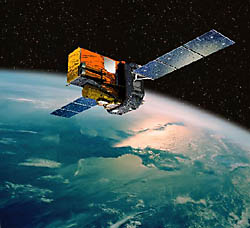INTEGRAL The International Gamma-Ray Astrophysics
Laboratory (INTEGRAL) of the European Space Agency was successfully launched
on October 17, 2002. It was lifted off from Baikonur in Kazakhstan on
a Russian Proton launcher and is now on a 72-hour elliptical orbit,
ranging from 9,000 km up to 155,000 km from Earth.
INTEGRAL is the successor of the ESA gamma-ray observatory Cos-B
and the NASA gamma-ray Observatory CGRO. It is producing a complete map
of the sky in the soft gamma-ray waveband and it is capable
of performing high spectral and spatial observations in gamma rays.
The observatory is also equipped with X-ray and optical detectors
to provide simultaneous observations in these wavebands.
The International Gamma-Ray Astrophysics
Laboratory (INTEGRAL) of the European Space Agency was successfully launched
on October 17, 2002. It was lifted off from Baikonur in Kazakhstan on
a Russian Proton launcher and is now on a 72-hour elliptical orbit,
ranging from 9,000 km up to 155,000 km from Earth.
INTEGRAL is the successor of the ESA gamma-ray observatory Cos-B
and the NASA gamma-ray Observatory CGRO. It is producing a complete map
of the sky in the soft gamma-ray waveband and it is capable
of performing high spectral and spatial observations in gamma rays.
The observatory is also equipped with X-ray and optical detectors
to provide simultaneous observations in these wavebands.
Mission CharacteristicsSimultaneous Gamma-ray, X-ray and Optical observations.
* INTEGRAL artist’s view courtesy of ESA. Page authors: Lorella Angelini Jesse Allen HEASARC Home | Observatories | Archive | Calibration | Software | Tools | Students/Teachers/Public Last modified: Monday, 07-Nov-2022 11:16:26 EST |

